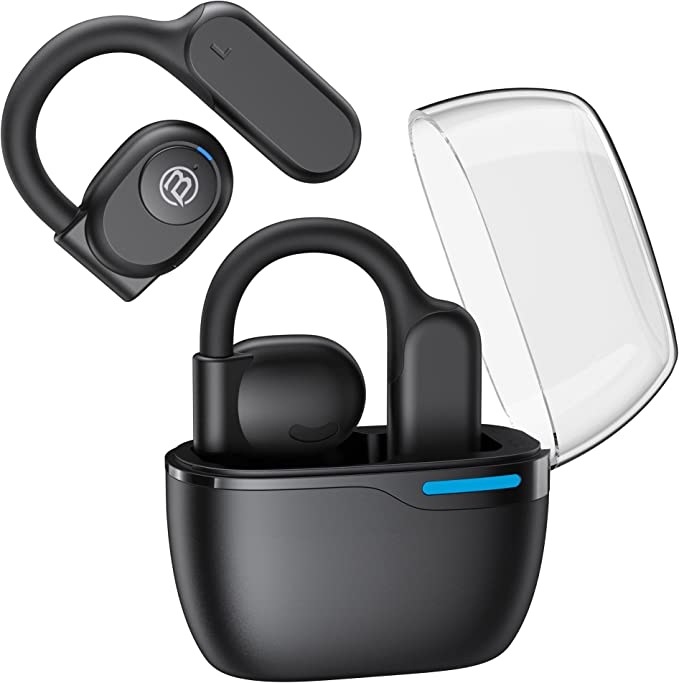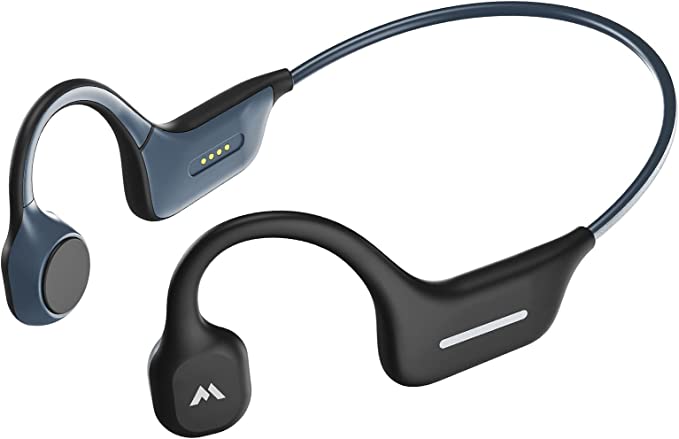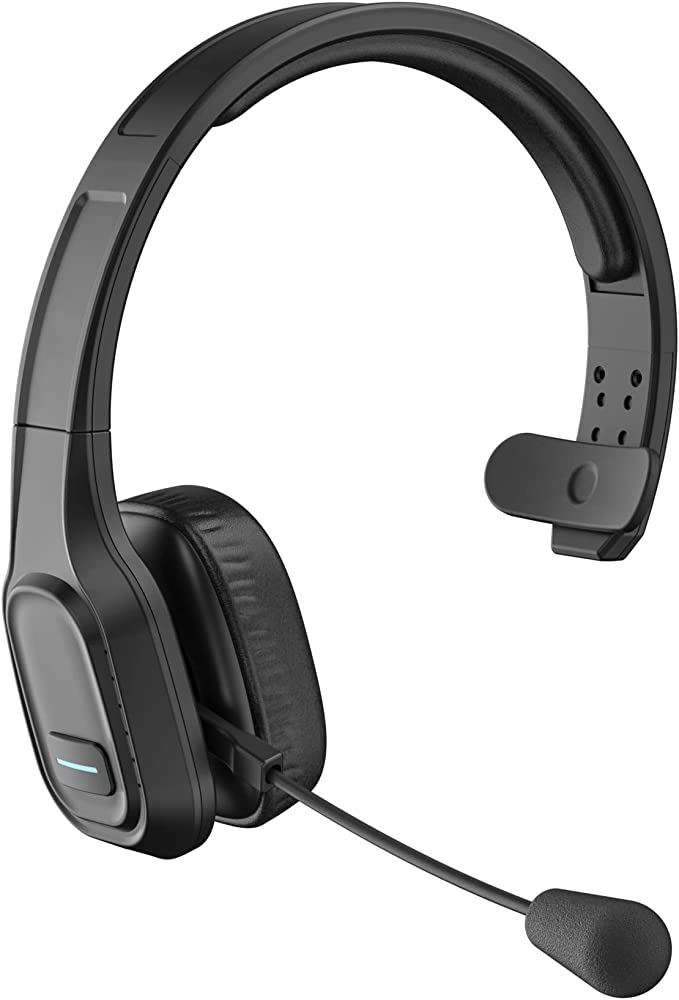The world hums with a symphony of sounds, a constant stream of information, music, and connection. For decades, we’ve sought to curate our personal slice of this auditory world with headphones. From the cumbersome cans of yesteryear to the tiny, almost invisible buds of today, the quest has always been for better sound, greater convenience. But as our lives become more dynamic, our need for audio technology that seamlessly integrates, rather than isolates, has grown more profound. We crave immersive music during a morning run but also need to hear the approaching cyclist. We desire crystal-clear calls for work but want to remain aware of a child’s query from the next room. This is the modern listener’s paradox, and it’s where the concept of open-ear listening is striking a powerful, resonant chord.
Today, we’ll journey into this evolving soundscape, using the BUGANI OpenFree Open Ear Wireless Headphones as our lens to explore the science, the comfort, and the sheer practicality of hearing your world and your audio, all at once.

Decoding “Open-Ear”: A Breath of Fresh Air for Your Ears (and Mind)
What does “open-ear” truly mean when we talk about headphones? It’s more than just a trendy label; it’s a fundamental shift in how sound is delivered to our auditory system. Unlike traditional in-ear headphones that seal off the ear canal, or even bone conduction headphones that bypass the outer ear to send vibrations through your skull, true open-ear headphones, like the BUGANI OpenFree, work on the principle of air conduction without occlusion. Imagine sound being gently guided towards your ear canal, much like hearing sounds naturally in your environment, but personalized and private. The earbuds themselves rest lightly on top of or around the outer ear, leaving the ear canal completely unobstructed.
Think of it like this: traditional earbuds are like listening to an orchestra while wearing perfectly fitted earplugs that pipe the music directly in – very immersive, but you’re cut off. Bone conduction is like feeling the vibrations of the bass through the floorboards. Open-ear listening, however, is akin to being in a well-designed acoustic space where the music is clear and present, yet you can still hear the gentle murmur of the audience or a door opening nearby.
This “unblocked” approach is central to the comfort and ergonomic philosophy behind the BUGANI OpenFree. As an audiologist and someone who has studied the biophysics of hearing for years, I can appreciate the meticulous attention to how these devices interact with the human ear. These headphones are crafted to follow the natural, complex curves of the auricle (the external part of your ear). Weighing a mere 0.2 ounces – that’s less than a single sheet of paper – and fashioned from a premium soft silicone material, they employ what BUGANI calls a “multi-point support system.” This isn’t just marketing fluff; it’s applied ergonomics. By distributing the minimal weight evenly across several contact points, the design aims to eliminate the pressure spots and pinching that can make traditional on-ear or even some over-ear headphones uncomfortable after prolonged use.
More importantly, by leaving the ear canal open, you sidestep several common issues. There’s no “ear canal fatigue” – that plugged-up, sometimes achy feeling some experience with in-ear buds. Hygiene is improved, as moisture and wax buildup within a sealed canal are less of a concern. For individuals who use hearing aids (typically behind-the-ear models), this non-occluding design can be a game-changer, allowing them to enjoy personal audio without interfering with their hearing instruments. It’s a design that truly breathes.

The Heart of the Matter: Unpacking the BUGANI OpenFree’s Sound Engine
Now, let’s delve into what truly makes any audio device sing: its sound engine. The BUGANI OpenFree headphones boast dual 16.2mm dynamic drivers, a specification that immediately piques an audio enthusiast’s interest. Why? Because in the realm of speaker design, size often does matter.
Imagine a drum kit. A large bass drum, with its wide, resonant surface, produces deep, booming sounds that you can almost feel. A smaller snare drum, with its tighter, smaller head, produces sharper, higher-pitched cracks. Dynamic drivers in headphones work on a similar principle. They consist of a diaphragm (a thin membrane), a voice coil, and a magnet. When an electrical audio signal passes through the voice coil, it creates a magnetic field that causes the voice coil and attached diaphragm to vibrate rapidly, moving air and thus creating sound waves.
A larger diaphragm, like the 16.2mm ones found here (which BUGANI claims are three times the size of typical in-ear earbud drivers), has a greater surface area. This allows it to move a larger volume of air with each vibration. The direct consequence? The potential for a richer, more extended low-frequency response – what we perceive as deep bass. It also contributes to a fuller, more expansive soundstage, making music feel more open and less confined. Furthermore, larger drivers, when well-engineered, can often produce higher sound pressure levels (volume) with less distortion compared to smaller drivers being pushed to their limits.
BUGANI pairs these sizeable drivers with what they term “top bio-diaphragm technology.” While “bio-diaphragm” can encompass a range of materials (often cellulose-based or other biologically derived polymers), the goal is usually to create a diaphragm that is extremely lightweight yet rigid. This combination allows the diaphragm to respond with incredible speed and precision to the audio signal, minimizing unwanted resonances or “breakup” that can color the sound. The result, ideally, is a faithful reproduction of the original audio signal across the entire frequency spectrum – from those crisp and clear highs to the excitingly powerful lows, delivering a consistent and engaging HiFi stereo listening experience at any volume.

The Unseen Conductor: Wireless Fidelity with Bluetooth 5.3
In our untethered world, the quality of the wireless connection is as crucial as the acoustic hardware itself. The BUGANI OpenFree headphones incorporate Bluetooth 5.3, one of the more recent iterations of this ubiquitous wireless standard. This isn’t just about the convenience of ditching wires; each Bluetooth generation brings tangible improvements.
Bluetooth 5.3 offers several key advantages pertinent to your listening experience. Firstly, it typically provides faster transmission speeds and greater bandwidth compared to older versions. BUGANI suggests it’s up to twice the speed of some previous standards. This translates to a more robust and stable connection, reducing the likelihood of annoying signal dropouts or music interruptions, especially in environments with a lot of wireless traffic. Think of it as upgrading from a narrow country lane to a multi-lane highway for your audio data.
Secondly, Bluetooth 5.3 is engineered for lower power consumption. This is a significant boon for battery-powered devices like wireless headphones. More efficient data transmission and smarter power management mean that the headphones can eke out more listening time from their internal batteries, contributing to that impressive 30-hour total playtime claim with the charging case.
Now, a word on latency – that perceptible delay between what you see on a screen and what you hear. This is particularly critical for watching videos or playing games. The product specifications for the BUGANI OpenFree mention aptX Low Latency technology. aptX is a family of audio codecs (coder-decoders) designed to compress and decompress digital audio for Bluetooth transmission with higher fidelity and, in the case of its Low Latency variant, with reduced delay. While the actual presence and performance of specific codecs like aptX can sometimes depend on both the transmitting device (your phone or computer) and the receiving device (the headphones) supporting it identically—and it’s worth noting that user experiences can vary—the industry’s focus on minimizing latency is vital. When it works as intended, low latency technology ensures that dialogue syncs perfectly with an actor’s lips, and the sound of an explosion in a game arrives precisely when you see it, making for a far more immersive experience.

“Can You Hear Me Now?” – The Science of Crystal Clear Calls with ENC
Beyond listening to music or podcasts, clear communication is a cornerstone of modern headphone usage. The BUGANI OpenFree headphones feature Environmental Noise Cancellation (ENC), but it’s important to understand precisely what this technology does. Unlike Active Noise Cancellation (ANC) in many over-ear headphones, which aims to silence the outside world for the listener, ENC in this context is primarily about ensuring your voice is transmitted clearly to the person on the other end of your call.
How does it achieve this? It’s a clever bit of acoustic engineering. These headphones utilize dual microphones. One microphone is typically positioned to optimally capture your voice. The other microphone (or microphones) is strategically placed to listen to the sounds of your surrounding environment – the traffic noise, the office chatter, the café buzz. The magic happens in the digital signal processing (DSP) chip within the headphones. This chip analyzes the ambient sounds picked up by the secondary microphone and generates an “anti-noise” signal – a sound wave that is the exact inverse (180 degrees out of phase) of the unwanted background noise.
When this anti-noise signal is combined with the microphone signal capturing your voice, it effectively cancels out a significant portion of that steady background clamor before the audio is transmitted to your caller. Imagine you’re a bouncer at a club, and your voice is the VIP guest you want to usher through the velvet rope. ENC acts like your assistant, identifying and politely holding back the general crowd (background noise) so your VIP (your voice) can pass through unimpeded and be heard with distinction. This results in crystal clear calls, making you sound like you’re communicating face-to-face, even when you’re navigating a less-than-serene environment.

Designed for Life’s Adventures (and Mishaps): Durability and Power
A pair of headphones, especially those designed for an active lifestyle, needs to be more than just a delicate audio instrument; it needs to be a robust companion. The BUGANI OpenFree headphones come with an IPX6 certified waterproof rating. Let’s decode that. The “IP” stands for Ingress Protection, and it’s a standardized system for rating how well a device is protected against intrusion from solids (the first digit, an ‘X’ here means it wasn’t tested for dust specifically in this rating) and liquids (the second digit).
An IPX6 rating signifies that the headphones are protected against powerful water jets from any direction. This doesn’t mean you should go swimming with them (for that, you’d typically look for IPX7 or IPX8), but it does mean they can comfortably handle heavy rain, significant splashing, and, crucially for many users, copious amounts of sweat during intense workouts. This resilience is often achieved through a combination of careful sealing of seams and ports, and the application of a nano-coating on the internal and external components. This invisible, water-repellent layer causes moisture to bead up and roll off, rather than seeping in and damaging the sensitive electronics. So, whether you’re caught in a downpour on your cycle home or pushing through a grueling gym session, the IPX6 rating offers valuable peace of mind.
Powering these auditory adventures is a combination of a large-capacity battery and what BUGANI describes as “breakthrough low-consumption algorithms.” The result, according to their lab tests at 60% volume, is up to 12 hours of continuous playback from the earbuds on a single charge, with the sleek charging case extending this to a total of 30 hours of playtime. It’s always wise to remember that real-world battery life can vary based on volume levels, the type of audio content, connection stability, and even ambient temperature, but these figures suggest ample stamina for several days of typical use. And when it’s finally time to refuel, the adoption of the international universal Type-C charging port is a welcome convenience, allowing for a full charge of the case in a relatively brisk 1-2 hours.
Listening Wisely: Open-Ear, Hearing Health, and You
One of the most compelling arguments for open-ear headphone designs, and one that resonates deeply with me as an audiologist, is their potential positive impact on hearing health. Traditional in-ear earbuds, by their very nature, create a seal within the ear canal. This can, for some individuals or with improper use, lead to a few concerns. Firstly, sound is directed very efficiently and deeply into the ear, potentially increasing the risk of hearing damage if volumes are consistently too high. Secondly, the occluded environment can trap moisture and reduce ventilation, which may contribute to ear infections or irritation for susceptible individuals.
Open-ear designs, like that of the BUGANI OpenFree, inherently sidestep these specific issues. Because they don’t enter or seal the ear canal:
- There’s no direct pressure build-up inside the canal.
- Sound is dispersed in a more natural way before entering the ear, which may lead to users choosing slightly lower volumes for comfortable listening, though this is user-dependent.
- The ear canal remains open to air, promoting better ventilation and potentially reducing the aforementioned hygiene concerns.
However, it’s crucial to approach this with a balanced perspective. One user of a similar open-style product (noted in general product feedback I’ve reviewed) mentioned an audiologist’s concern about the back part of some open-ear devices potentially contacting the nerve or bone behind the ear. While the BUGANI OpenFree rests on the ear and doesn’t rely on bone conduction transmission directly, it underscores an important point: any audio device, if poorly designed, improperly fitted, or used irresponsibly (e.g., at excessively high volumes for prolonged periods), carries potential risks.
The key to hearing health with any headphone technology lies in:
- Moderate Volume: Never listen so loudly that you can’t hear fairly loud external sounds, or that someone next to you can clearly hear your music.
- Listening Breaks: Give your ears regular rests, especially during long listening sessions. The 60/60 rule is a good guideline: listen at no more than 60% of maximum volume for no more than 60 minutes at a time.
- Proper Fit and Awareness: Ensure the device is comfortable and not causing undue pressure on any part of your ear.
Open-ear designs offer a wonderful advantage in maintaining situational awareness, allowing you to enjoy your audio while staying connected to the sounds of your environment. This is not just a convenience; it’s a safety feature, especially for outdoor activities.
The Little Things That Matter: Usability and Thoughtful Design
Beyond the core specifications of sound, connectivity, and durability, the everyday usability of a device often hinges on the “little things.” The BUGANI OpenFree incorporates Smart Touch Controls, allowing users to manage music playback, adjust volume, handle phone calls, and access their phone’s voice assistant with simple taps on the earbuds. This kind of intuitive interface minimizes the need to constantly reach for your phone.
Furthermore, features like One-Step Pairing, often facilitated by a Hall switch in the charging case (which detects when the lid is opened), streamline the initial connection process. After the first setup, the headphones are designed to automatically connect to your paired device as soon as you open the case, getting you to your audio faster.
It’s also worth reflecting on how holistic design impacts the user experience. While we’ve focused on the advanced technology within the BUGANI OpenFree, seemingly minor physical details in any wearable device—such as the tactile feedback of a control button, the ease of opening a charging case, the intuitive placement of a charging port, or the robustness of a hinge mechanism—collectively contribute significantly to long-term user satisfaction and the perception of quality. When these details are thoughtfully executed, they elevate the entire experience from merely functional to genuinely enjoyable.

Coda: The Future is Open – Redefining Your Personal Soundscape
The BUGANI OpenFree Open Ear Wireless Headphones serve as a fascinating case study in the ongoing evolution of personal audio technology. They exemplify a growing trend towards solutions that don’t force us to choose between immersing ourselves in sound and engaging with the world around us. Instead, they offer a pathway to harmoniously blend the two.
What these headphones, and the broader category of open-ear audio, suggest is a future where our technology adapts more intelligently and comfortably to the nuances of human anatomy and our multifaceted lives. It’s a future where you can seamlessly transition from a work call to a podcast on your commute, to enjoying your running playlist, all while remaining present, aware, and, most importantly, comfortable.
Ultimately, the best audio device is one that not only delivers on its technical promises but also enriches your daily life without adding friction. As we’ve explored the science and design behind the BUGANI OpenFree, I hope you feel more empowered to understand what goes into creating such an experience, and to make informed choices that resonate with your own unique listening needs and preferences. The world of sound is vast and wonderful; technology like this simply gives us new, more versatile ways to tune in.




